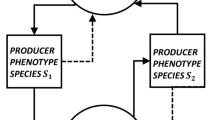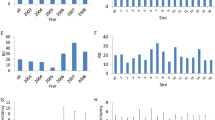Abstract
Theoretical models of plant seed banks and common sense suggest that stores of dormant propagules must slow down the rate of genetic change1,2 because they sequester a substantial fraction of the gene pool from the influence of microevolutionary processes in each generation. The magnitude of the effect must represent a balance between the extent of selection and the fraction of the dormant pool that returns to the active population in each generation (and the other microevolutionary processes of migration, drift and mutation). For most populations, in which to observe the action of selection is difficult in itself, detecting the added influence of a dormant propagule pool will be more difficult still. Here we report the effect of hatching of diapausing eggs from lake sediments on the rate of phenotypic change in two populations of the freshwater copepod, Diaptomus sanguineus. When the input of new eggs to the sediments was eliminated by a brief but intense two-year appearance of predators, the role of dormant stages in slowing evolution was clearly seen.
This is a preview of subscription content, access via your institution
Access options
Subscribe to this journal
Receive 51 print issues and online access
$199.00 per year
only $3.90 per issue
Buy this article
- Purchase on Springer Link
- Instant access to full article PDF
Prices may be subject to local taxes which are calculated during checkout
Similar content being viewed by others
References
Templeton, A. R. & Levin, D. A. Am. Nat. 114, 232–249 (1979).
Brown, J. S. & Venable, D. L. Am. Nat. 127, 31–47 (1986).
Hairston, N. G. Jr & Munns, W. R. Jr Am. Nat. 123, 733–751 (1984).
Hairston, N. G. Jr & Olds, E. J. Oecalogia 61, 42–48 (1984).
Hairston, N. G. Jr, Walton, W. E. & Li, K. T. Limnol. Oceanogr. 28, 935–947 (1983).
Hairston, N. G. Jr, Olds, E. J. & Munns, W. R. Jr Verh. int. Verein. theor. angew. Limnol. 22, 3170–3177 (1985).
Hairston, N. G. Jr & Walton, W. E. Proc. natn. Acad. Sci. U.S.A. 83, 4831–4833 (1986).
Hairston, N. G. Jr in Predation: Direct and Indirect Impacts on Aquatic Communities (eds Kerfoot, W. C. & Sih, A.) 281–290 (University Press New England, Hanover, New Hampshire, 1987).
Hairston, N. G. Jr & Spalding, J. Am. Nat. 131, 678–699 (1988).
Falconer, D. S. Introduction to Quantitative Genetics 2nd edn (Longmann, New York, 1981).
Marcus, N. H. Mar. Ecol. Prog. Ser. 15, 47–54 (1984).
Champeau, A. Ann. Fac. Sci. Marseille 44, 155–189 (1970).
Davis, M. B. Ecology 50, 409–421 (1969).
Griffiths, M. & Edmondson, W. T. Limnol. Oceanogr. 20, 945–952 (1975).
Lehman, J. T. Quat. Res. 5, 541–550 (1975).
Davis, R. B. & Anderson, D. S. Hydrobiologia 120, 69–87 (1985).
Moritz, C. Hydrobiologia 145, 309–314 (1987).
Davis, R. B. Limnol. Oceanogr. 19, 342–346 (1974).
Likens, G. E. & Davis, M. B. Verh. int. Verein. theor. angew. Limnol. 19, 982–993 (1975).
von Ende, C. N. Ecology 60, 119–128 (1979).
Fedorenko, A. Y. Limnol. Oceanogr. 20, 250–258 (1975).
Pastorok, R. A. in Evolution and Ecology of Zooplankton Communities (ed. Kerfoot, W. C.) 538–554 (University Press New England, Hanover, New Hampshire, 1980).
Walton, W. E. J. Plank, Res. 10, 110–114 (1988).
Author information
Authors and Affiliations
Rights and permissions
About this article
Cite this article
Hairston Jr, N., De Stasio Jr, B. Rate of evolution slowed by a dormant propagule pool. Nature 336, 239–242 (1988). https://doi.org/10.1038/336239a0
Received:
Accepted:
Published:
Issue Date:
DOI: https://doi.org/10.1038/336239a0
This article is cited by
-
Bacteria-phage coevolution with a seed bank
The ISME Journal (2023)
-
Principles of seed banks and the emergence of complexity from dormancy
Nature Communications (2021)
-
The power of numbers: dynamics of hatching and dormant egg production in two populations of the water flea Daphnia magna
Aquatic Ecology (2019)
-
Rapid evolution with generation overlap: the double-edged effect of dormancy
Theoretical Ecology (2019)
-
The anchoring effect—long-term dormancy and genetic population structure
The ISME Journal (2018)
Comments
By submitting a comment you agree to abide by our Terms and Community Guidelines. If you find something abusive or that does not comply with our terms or guidelines please flag it as inappropriate.



